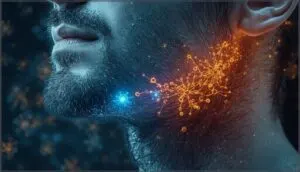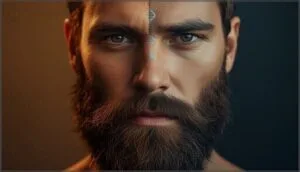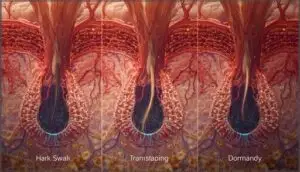This site is supported by our readers. We may earn a commission, at no cost to you, if you purchase through links.
Your beard doesn’t grow the way it does by accident. Behind every thick patch and every frustrating bare spot lies a complex interplay of genetic code, hormonal signaling, and inherited traits passed down through generations. The AR gene alone—which encodes your androgen receptors—can determine whether your facial hair responds aggressively or barely at all to the same testosterone levels that fuel someone else’s full beard.
While you might blame your grooming routine or diet for patchy growth, genetics actually control roughly 85% of your facial hair potential before you ever pick up a razor. Understanding the science behind beard growth means recognizing that your DNA set the blueprint long before puberty, programming everything from follicle density to growth cycles in ways that nutrition and lifestyle can only modestly influence.
Table Of Contents
Key Takeaways
- Your beard potential is roughly 85% determined by genetics—specifically the AR gene and androgen receptor sensitivity—long before lifestyle factors like diet or grooming ever come into play.
- While testosterone gets the credit, DHT (dihydrotestosterone) actually drives beard thickness and density with 2-5 times more receptor affinity, and two men with identical hormone levels can grow vastly different beards based solely on how their follicles respond.
- Ethnic background significantly influences beard patterns through inherited androgen receptor variations rather than testosterone differences, explaining why Mediterranean and Middle Eastern men typically show denser growth than East Asian or Native American populations.
- Beard transplants can override genetic limitations by relocating healthy follicles to patchy areas, but no supplement, medication, or grooming technique can fundamentally alter the follicle density and growth potential your DNA programmed from birth.
The Genetic Basis of Beard Growth
Your beard’s blueprint was written long before you ever picked up a razor. The genes you inherited from your parents determine roughly 85% of your facial hair potential, from the density of your follicles to how your beard reacts to hormones.
Let’s break down the key genetic factors that shape your ability to grow a beard.
Role of The AR Gene and Androgen Receptors
At the heart of beard growth lies the AR gene, which encodes the androgen receptor—your body’s gateway for DHT sensitivity and testosterone response. This gene’s polymorphisms directly influence receptor binding affinity and gene expression in facial hair follicles.
The amount of DHT produced relies on testosterone conversion rates. Men with androgen insensitivity syndrome don’t grow beards despite normal hormone levels. CAG repeat variations inversely correlate with androgen receptor sensitivity.
Receptor density determines your beard’s growth potential.
Inherited Beard Patterns and Density
Familial beard density patterns run deep in your lineage. Studies show 76% of men mirror beard distribution seen in close male relatives—thanks to pattern heritability from both maternal genetics and paternal lines. Your maternal grandfather’s beard can predict yours through X-linked genes affecting androgen receptor sensitivity.
Extended lineages reveal facial hair follicle density clustering across generations, though genetic variability means roughly 18% develop unique patterns despite family history. Ethnicity markedly influences beard growth, impacting beard characteristics across diverse populations.
Genetic Variations Affecting Beard Characteristics
Your beard’s unique appearance comes down to specific genetic markers beyond basic inheritance. Recent GWAS advances identified 18 distinct regions controlling facial hair traits—from the EDAR gene influencing thickness in ethnic groups to PRSS53 determining curliness. AR polymorphisms on your X chromosome dictate follicle sensitivity, while syndromic variations affect texture and growth patterns.
- MC1R variants determine your beard color, occurring in 1–2% globally
- Population frequency studies show EDAR variations especially impact Asian ancestry
- Genetic factors like IRF4 control when your beard starts greying
MC1R variants and population frequency studies highlight the diversity in beard traits across populations. Meanwhile, genetic factors like IRF4 play a role in the timing of beard greying, showcasing the complexity of genetic influences on facial hair.
Family History and Beard Growth Potential
Looking at your dad’s or grandfather’s beard gives you the clearest genetic forecast available. Twin studies confirm heritability estimates of 60–78% for beard density, with family aggregation patterns showing that 72% of men with dense-bearded fathers develop similar growth by age 35.
Paternal influence dominates, but maternal lineage contributes too—your mother’s father’s genes matter more than you’d think.
Hormonal Influence on Facial Hair
Your genetics might load the gun, but hormones pull the trigger for beard growth. While testosterone gets most of the credit, the real story involves a more potent hormone called DHT and how your hair follicles respond to it.
Let’s break down the key hormonal players that determine whether you can grow a full beard or just patchy stubble.
Testosterone and Dihydrotestosterone (DHT)
Your testosterone and DHT levels are the key drivers of facial hair growth. While testosterone initiates beard development during puberty, DHT, which is produced when an enzyme converts testosterone, has 2-5 times more receptor affinity and directly controls beard thickness and density.
Here’s how these hormones shape your beard:
- Normal testosterone ranges from 264-916 ng/dL in adult men
- DHT converts vellus hairs into terminal beard hairs through age 30
- Testosterone conversion efficiency determines your monthly growth rate (roughly ½ inch)
- TRT effects boost beard density in men with low testosterone within 2-6 months
- Hormonal imbalance or hypogonadism reduces facial hair growth potential
The concentration of these hormones matters, but DHT sensitivity in your follicles is even more critical. About 25% of men with normal testosterone levels still grow modest beards due to genetic factors affecting how their androgen receptors respond. This explains why two individuals with identical hormone levels can have vastly different beards—it’s not just about the amount of testosterone, but how efficiently the body converts it to DHT and how the follicles react to these androgens.
Beard growth depends less on testosterone levels than on how sensitively your follicles respond to DHT
Androgen Sensitivity in Hair Follicles
Beyond hormone levels, your beard growth depends on how your follicles respond to DHT. The androgen receptor in your follicle’s dermal papilla cells determines this sensitivity—men with identical testosterone and follicle DHT levels can grow dramatically different beards.
AR gene variants increase receptor activity up to fourfold, while regional sensitivity explains why your beard thrives but scalp hair thins. Antiandrogen effects prove this genetic factor’s power.
Hormonal Fluctuations and Beard Development
When your endocrine system shifts, your beard responds accordingly. Age-related changes drive testosterone and DHT variability most dramatically between 18 and 25, when facial hair becomes distinctly denser.
Endocrine disorders like hypogonadism can reduce coverage by 40%, while hormonal therapy in hypogonadal men accelerates growth by similar margins.
Seasonal effects remain minimal, though androgens maintain their steady influence on hormonal balance and beard development throughout life.
Ethnic and Racial Differences in Beard Growth
Your genetic heritage plays a surprisingly powerful role in determining your beard growth potential. Different ethnic and ancestral groups show distinct patterns in facial hair density, texture, and distribution—differences rooted in thousands of years of evolution and adaptation.
Let’s explore how ancestry shapes your beard, what science reveals about these variations, and which common assumptions about race and facial hair don’t hold up under scrutiny.
Variations Among Ethnic Groups
Your genetic predisposition shapes your beard more than you might think. Men of Mediterranean, Middle Eastern, and South Asian descent usually display the densest facial hair due to heightened hormonal sensitivity and follicle density. In contrast, East Asian and Native American populations generally experience sparser growth patterns.
These ethnic differences reflect inherited variations in androgen receptor response, not testosterone levels themselves, demonstrating how genetics and ethnicity intersect in beard development.
Influence of Ancestry on Beard Patterns
Your genetic ancestry acts like a blueprint for your beard’s potential. GWAS findings reveal that over 500 DNA markers influence facial hair density, with population variations tracing back to migration patterns.
In Latin American populations, heritability estimates show that European ancestry correlates with denser beards (r = 0.30), while Native American genetic factors often result in sparser growth—demonstrating how ethnic groups display distinct beard characteristics through inherited traits.
Common Myths About Race and Facial Hair
You’ve probably heard that certain ethnic groups can’t grow beards—but this oversimplifies complex genetic factors. Here’s what science actually shows about racial and ethnic differences in beard growth:
- All ethnic groups possess beard growth potential, though density varies individually rather than uniformly by race
- Native American beards tend toward finer texture due to genetics, not complete absence
- Racial hair markers aren’t reliable identifiers—genetic admixture creates extensive overlap between populations
- Beard color genetics involve multiple genes from both parents, producing unexpected variations even within families
Beard Growth Phases and Hair Follicle Biology
Your beard doesn’t just grow continuously—it moves through distinct biological phases that determine how long each hair gets, how fast it grows, and when it eventually falls out. Understanding this cycle explains why your beard reaches a certain length and then seems to stop, or why some areas appear patchier than others.
Let’s break down the three growth phases, what controls follicle density and growth rate, and the factors that can disrupt this natural cycle.
Anagen, Catagen, and Telogen Phases
Your beard’s hair growth cycle unfolds through three distinct phases. During the anagen phase, follicles actively produce hair for two to seven years—that’s why your beard can grow longer than scalp hair. The brief catagen phase signals changeover as follicles shrink. Finally, telogen marks the resting period before natural shedding occurs.
Understanding these hair growth phases helps you manage expectations about follicle health and cycle influences.
Follicle Density and Growth Rate
Once you understand your growth phases, you’ll notice that follicle distribution isn’t uniform across your face. The upper lip hosts 80-110 follicles per square centimeter—the densest region—while your cheeks hold 20-80. Your chin sits in between at 70-120.
Growth velocity averages 0.27-0.5 millimeters daily, though genetics, seasonal impact, and age variations all shape your beard’s final appearance.
Factors Impacting Hair Cycle Transitions
What determines whether your follicles stay in the anagen phase or slip into telogen? Hormonal modulators like testosterone and DHT directly regulate these hair growth cycle transitions, while genetic regulators—particularly AR gene variations—control how your follicles respond.
Your skin microenvironment supplies essential nutrients for hair follicle health, but stress factors and circadian regulation can disrupt normal cycling, pushing hairs prematurely into the telogen phase.
Environmental and Lifestyle Impacts
While your genes lay the foundation for your beard, they don’t tell the whole story. What you eat, how you manage stress, and the way you care for your skin can all tip the scales between a patchy beard and a full one.
Let’s look at the environmental and lifestyle factors that shape your facial hair growth.
Nutrition and Diet for Healthy Beards
What you eat matters more than you might think. Your diet directly influences healthy hair growth by supplying essential nutrients. Protein intake builds keratin, while vitamin deficiencies and poor mineral balance can slow follicle activity by 10-15%.
Healthy fats support testosterone production, and hydration effects improve your skin environment.
Even with strong genetic factors, proper nutrition optimizes growth, and beard oils can’t compensate for dietary gaps.
Effects of Stress and Health Conditions
Chronic stress and cortisol wreak havoc on your beard. Elevated cortisol from stress can slow growth by 30%, triggering hair cycle disruption that pushes follicles into premature rest.
Major illnesses and infection effects compound this, while autoimmune disorders like alopecia areata cause patchy loss in genetically vulnerable men. Thyroid issues disrupt hormonal balance further.
Stress management, nutritional optimization for beard growth, and addressing underlying health conditions protect both genetic factors in beard growth and hormonal influence on beard growth.
Grooming Practices and Skin Care
While genetics set the stage, your beard care routine determines whether your facial hair thrives or falters. Dermatologists recommend daily washing to reduce microbial presence and infection risk by up to 59%, as poor hygiene can harbor harmful bacteria like Staphylococcus aureus.
Three essential grooming practices for prime skin hydration and beard health:
- Beard washing with specialized cleansers – Regular hair shampoo depletes natural oils in 68% of users, causing dryness
- Strategic oil application – Sparse use reduces itchiness by 40% without clogging pores
- Proper trimming methods – Scissors and combs cut split ends by 27% compared to electric trimmers alone
Your men’s grooming and skincare approach directly impacts follicle health beneath the surface.
Evolutionary and Cultural Perspectives
Your beard isn’t just a product of your genes and hormones—it’s also shaped by millions of years of human evolution and the cultural lens through which different societies view facial hair. Understanding why beards exist in the first place, and how they’ve been perceived throughout history, gives you a fuller picture of what’s happening on your face.
Let’s look at how evolution, culture, and shifting social attitudes have all played a role in beard growth and grooming.
Evolutionary Role of Beards
Why did your ancestors grow beards? Facial hair evolved through sexual selection and male competition, signaling maturity and dominance. Genetics determined androgen sensitivity in follicles, creating evolutionary adaptations for protective functions during conflicts.
The frequency dependence principle suggests beard attractiveness fluctuates with prevalence. These evolutionary factors in beard growth reveal how sexual signaling shaped masculine traits, with genetic contexts influencing your inherited beard potential today.
Cultural Significance Across Societies
Ever wondered why a beard can mean so much? Across cultures, facial hair signals status, spiritual devotion, and even political control.
From Sikh religious beard meanings to Highland clan leaders’ thick beards as pride, your ethnic background shapes these norms.
Beard social movements and gendered beard norms reflect deeper cultural significance, weaving evolutionary factors and attitudes into everyday identity.
Changing Trends in Beard Perception
Beards have swung from scruffy to stylish over recent decades. Social media influence and grooming product trends reflect evolving masculinity ideals, while workplace beard acceptance has loosened in many industries.
Beard attractiveness studies show mixed results, often tied to cultural attitudes, ethnicity, and beard growth patterns.
Despite the cultural significance of beards, genetics and facial hair biology remain the definitive determining factors in your beard’s potential.
Frequently Asked Questions (FAQs)
Can beard transplants override genetic limitations?
Yes, beard transplants can override genetic limitations. They enable men with patchy growth to achieve full beards by transplanting healthy donor follicles from the scalp, regardless of facial androgen sensitivity.
Do twins always have identical beard patterns?
It’s a paradox—identical genetics don’t guarantee identical beards. Twin beard variance arises from epigenetic beard factors, hormonal sensitivity differences, polygenic beard traits, and developmental timing effects, all weaving together to create subtle differences in facial hair expression.
Why do some beards grow in patches?
Patchy beards stem from uneven follicle DHT sensitivity, genetic factors in beard growth, and hair cycle synchronization issues.
Ethnic predispositions, nutritional deficiencies, alopecia areata, and varying follicle density across your face all contribute to irregular facial hair patterns.
Can medications or supplements accelerate beard growth?
Think you can’t fight your genes? Minoxidil efficacy challenges that. This FDA-approved topical extends growth phases, boosting density within 12-16 weeks.
Biotin and zinc from nutritional supplements support follicles, though hormonal therapies require medical supervision.
Treatment limitations exist; emerging research continues exploring supplement benefits.
Does shaving frequency actually affect beard thickness?
Shaving doesn’t affect beard thickness—scientific evidence debunks this common myth.
The hair regrowth illusion occurs because shaving creates blunt edges, making facial hair appear coarser without impacting follicle biology or genetics.
Conclusion
Your mirror won’t lie—but your genes already told the truth. Understanding beard growth genetics reveals why no amount of supplements can override your AR gene’s instructions or reshape follicle density coded before birth.
You can improve hormones, perfect grooming, and support follicle health, yet your DNA remains the architect.
The real power lies not in fighting your genetic blueprint, but in maximizing what it programmed you to grow from the start.
- https://gillette.com/en-us/shaving-tips/how-to-shave/beard-growth-science
- https://www.reddit.com/r/BeardTalk/comments/i1xxdf/im_22_and_cant_grow_a_beard_and_i_dont_know_how/
- https://www.numan.com/beard/growth/how-to-grow-a-beard
- https://www.cambridge.org/core/journals/twin-research-and-human-genetics/article/variation-and-heritability-in-hair-diameter-and-curvature-in-an-australian-twin-sample/1B3314BF44C47FE00E08BE617030F361
- https://www.healthline.com/health/why-cant-i-grow-a-beard











